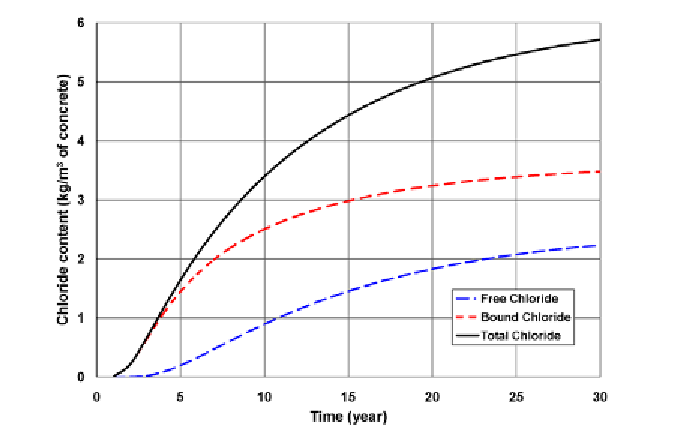Geology Reference
In-Depth Information
Using the developed finite difference algo-
rithm, a set of simultaneous equations are solved
in one-day time steps to determine the chloride
content in the concrete. Assuming that the water
to cement ratio is equal to 0.5, the calculated
free chloride content at the depth of 50 mm has
been shown in Figure 1. After obtaining the free
chloride content at each time step, the bound and
total chloride contents can be calculated using
Equations 1 and 3. The changes in bound and
total chloride contents during a 30-year period
can also be found in Figure 1.
The calculated free chloride content at differ-
ent time steps can be used to estimate the corrosion
initiation time,
t
i
. The corrosion initiation time is
determined as the time when the chloride concen-
tration near the reinforcing bars reaches the
threshold chloride concentration. This means:
chloride concentration causing depassivation of
the concrete protection film and initiation of the
corrosion process. There have been many research
efforts during the past three decades to determine
an appropriate threshold for the critical chloride
content. It had been first suggested that the critical
value should be determined by investigating the
free chloride concentration, but the study of Glass
and Buenfeld (2000) on the chemical aspects of
chloride binding capacity showed that the bound
chloride should also be taken into account. As a
result, the threshold value is expected to represent
the total chloride content. Figure 2 demonstrates
a summary of data available in the literature
regarding the measured or suggested values for
the critical chloride concentration. For this study,
the critical chloride concentration is considered
to be 1% of the cement weight which is assumed
to equal 350 kg.m
-3
.
The total chloride content profile given in
Figure 1 can be used to evaluate the corrosion
initiation time. Assuming the threshold value as
3.5 kg.m
-3
(1% of cement weight), the initiation
time can be estimated accordingly as 12.66 year
for. It is evident that different chloride binding
(
)
=
C t d
,
C
(7)
f
i
c
critical
where
d
c
is the depth at which the reinforcing bars
are placed (usually equal to the concrete cover
depth). In Equation 7, the
C
critical
is the threshold
Figure 1. Change in the free, bound, and total chloride contents during a 30-year period

Search WWH ::

Custom Search